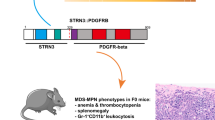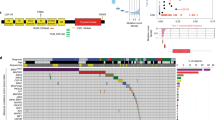Abstract
Myeloproliferative neoplasms are frequently associated with aberrant constitutive tyrosine kinase (TK) activity resulting from chimaeric fusion genes or point mutations such as BCR-ABL1 or JAK2 V617F. We report here the cloning and functional characterization of two novel fusion genes BCR-RET and FGFR1OP-RET in chronic myelomonocytic leukemia (CMML) cases generated by two balanced translocations t(10;22)(q11;q11) and t(6;10)(q27;q11), respectively. The two RET fusion genes leading to the aberrant activation of RET, are able to transform hematopoietic cells and skew the hematopoietic differentiation program towards the monocytic/macrophage lineage. The RET fusion genes seem to constitutively mimic the same signaling pathway as RAS mutations frequently involved in CMML. One patient was treated with Sorafenib, a specific inhibitor of the RET TK function, and demonstrated cytological and clinical remissions.
This is a preview of subscription content, access via your institution
Access options
Subscribe to this journal
Receive 12 print issues and online access
$259.00 per year
only $21.58 per issue
Buy this article
- Purchase on Springer Link
- Instant access to full article PDF
Prices may be subject to local taxes which are calculated during checkout



Similar content being viewed by others
References
Vardiman JW, Thiele J, Arber DA, Brunning RD, Borowitz MJ, Porwit A et al The 2008 revision of the World Health Organization (WHO) classification of myeloid neoplasms and acute leukemia: rationale and important changes. Blood 2009; 114: 937–951.
Tefferi A, Vainchenker W . Myeloproliferative neoplasms: molecular pathophysiology, essential clinical understanding, and treatment strategies. J Clin Oncol 2011; 29: 573–582.
Takahashi M, Ritz J, Cooper GM . Activation of a novel human transforming gene, ret, by DNA rearrangement. Cell 1985; 42: 581–588.
Plaza-Menacho I, Burzynski GM, de Groot JW, Eggen BJ, Hofstra RM . Current concepts in RET-related genetics, signaling and therapeutics. Trends Genet 2006; 22: 627–636.
Santoro M, Melillo RM, Fusco A . RET/PTC activation in papillary thyroid carcinoma: European Journal of Endocrinology Prize Lecture. Eur J Endocrinol 2006; 155: 645–653.
Kohno T, Ichikawa H, Totoki Y, Yasuda K, Hiramoto M, Nammo T et al KIF5B-RET fusions in lung adenocarcinoma. Nat Med 2012; 18: 375–377.
Lipson D, Capelletti M, Yelensky R, Otto G, Parker A, Jarosz M et al Identification of new ALK and RET gene fusions from colorectal and lung cancer biopsies. Nat Med 2012; 18: 382–384.
Marsh DJ, Mulligan LM, Eng C . RET proto-oncogene mutations in multiple endocrine neoplasia type 2 and medullary thyroid carcinoma. Horm Res 1997; 47: 168–178.
Skinner MA, Safford SD, Reeves JG, Jackson ME, Freemerman AJ . Renal aplasia in humans is associated with RET mutations. Am J Hum Genet 2008; 82: 344–351.
International Human Genome Sequencing Consortium Finishing the euchromatic sequence of the human genome. Nature 2004; 431: 931–945.
Beillard E, Pallisgaard N, van der Velden VH, Bi W, Dee R, van der Schoot E et al Evaluation of candidate control genes for diagnosis and residual disease detection in leukemic patients using 'real-time' quantitative reverse-transcriptase polymerase chain reaction (RQ-PCR) - a Europe against cancer program. Leukemia 2003; 17: 2474–2486.
Quelen C, Lippert E, Struski S, Demur C, Soler G, Prade N et al Identification of a transforming MYB-GATA1 fusion gene in acute basophilic leukemia: a new entity in male infants. Blood 2011; 117: 5719–5722.
Lavau C, Szilvassy SJ, Slany R, Cleary ML . Immortalization and leukemic transformation of a myelomonocytic precursor by retrovirally transduced HRX-ENL. EMBO J 1997; 16: 4226–4237.
Popovici C, Zhang B, Gregoire MJ, Jonveaux P, Lafage-Pochitaloff M, Birnbaum D et al The t(6;8)(q27;p11) translocation in a stem cell myeloproliferative disorder fuses a novel gene, FOP, to fibroblast growth factor receptor 1. Blood 1999; 93: 1381–1389.
Carlomagno F, Anaganti S, Guida T, Salvatore G, Troncone G, Wilhelm SM et al BAY 43-9006 inhibition of oncogenic RET mutants. J Natl Cancer Inst 2006; 98: 326–334.
Karaman MW, Herrgard S, Treiber DK, Gallant P, Atteridge CE, Campbell BT et al A quantitative analysis of kinase inhibitor selectivity. Nat Biotechnol 2008; 26: 127–132.
Hantschel O, Wiesner S, Guttler T, Mackereth CD, Rix LL, Mikes Z et al Structural basis for the cytoskeletal association of Bcr-Abl/c-Abl. Mol Cell 2005; 19: 461–473.
Huntly BJ, Shigematsu H, Deguchi K, Lee BH, Mizuno S, Duclos N et al MOZ-TIF2, but not BCR-ABL, confers properties of leukemic stem cells to committed murine hematopoietic progenitors. Cancer Cell 2004; 6: 587–596.
Cox MC, Panetta P, Venditti A, Abruzzese E, Del Poeta G, Cantonetti M et al New reciprocal translocation t(6;10) (q27;q11) associated with idiopathic myelofibrosis and eosinophilia. Leuk Res 2001; 25: 349–351.
Ackland SP, Westbrook CA, Diaz MO, Le Beau MM, Rowley JD . Evidence favoring lineage fidelity in acute nonlymphocytic leukemia: absence of immunoglobulin gene rearrangements in FAB types M4 and M5. Blood 1987; 69: 87–91.
Cuneo A, Ferrant A, Michaux JL, Boogaerts M, Demuynck H, Bosly A et al Clinical review on features and cytogenetic patterns in adult acute myeloid leukemia with lymphoid markers. Leuk Lymphoma 1993; 9: 285–291.
Visser M, Hofstra RM, Stulp RP, Wu Y, Buys CH, Willemze R et al Absence of mutations in the RET gene in acute myeloid leukemia. Ann Hematol 1997; 75: 87–90.
Melillo RM, Cirafici AM, De Falco V, Bellantoni M, Chiappetta G, Fusco A et al The oncogenic activity of RET point mutants for follicular thyroid cells may account for the occurrence of papillary thyroid carcinoma in patients affected by familial medullary thyroid carcinoma. Am J Pathol 2004; 165: 511–521.
Tauchi T, Miyazawa K, Feng GS, Broxmeyer HE, Toyama K . A coiled-coil tetramerization domain of BCR-ABL is essential for the interactions of SH2-containing signal transduction molecules. J Biol Chem 1997; 272: 1389–1394.
Gattei V, Celetti A, Cerrato A, Degan M, De Iuliis A, Rossi FM et al Expression of the RET receptor tyrosine kinase and GDNFR-alpha in normal and leukemic human hematopoietic cells and stromal cells of the bone marrow microenvironment. Blood 1997; 89: 2925–2937.
van Weering DH, Medema JP, van Puijenbroek A, Burgering BM, Baas PD, Bos JL . Ret receptor tyrosine kinase activates extracellular signal-regulated kinase 2 in SK-N-MC cells. Oncogene 1995; 11: 2207–2214.
Chiariello M, Visconti R, Carlomagno F, Melillo RM, Bucci C, de Franciscis V et al Signalling of the Ret receptor tyrosine kinase through the c-Jun NH2-terminal protein kinases (JNKS): evidence for a divergence of the ERKs and JNKs pathways induced by Ret. Oncogene 1998; 16: 2435–2445.
Hayashi H, Ichihara M, Iwashita T, Murakami H, Shimono Y, Kawai K et al Characterization of intracellular signals via tyrosine 1062 in RET activated by glial cell line-derived neurotrophic factor. Oncogene 2000; 19: 4469–4475.
Hwang JH, Kim DW, Suh JM, Kim H, Song JH, Hwang ES et al Activation of signal transducer and activator of transcription 3 by oncogenic RET/PTC (rearranged in transformation/papillary thyroid carcinoma) tyrosine kinase: roles in specific gene regulation and cellular transformation. Mol Endocrinol 2003; 17: 1155–1166.
Lam ET, Ringel MD, Kloos RT, Prior TW, Knopp MV, Liang J et al Phase II clinical trial of sorafenib in metastatic medullary thyroid cancer. J Clin Oncol 2010; 28: 2323–2330.
Kohlmann A, Grossmann V, Klein HU, Schindela S, Weiss T, Kazak B et al Next-generation sequencing technology reveals a characteristic pattern of molecular mutations in 72.8% of chronic myelomonocytic leukemia by detecting frequent alterations in TET2, CBL, RAS, and RUNX1. J Clin Oncol 2010; 28: 3858–3865.
Hibi S, Lohler J, Friel J, Stocking C, Ostertag W . Induction of monocytic differentiation and tumorigenicity by v-Ha-ras in differentiation arrested hematopoietic cells. Blood 1993; 81: 1841–1848.
Dorrell C, Takenaka K, Minden MD, Hawley RG, Dick JE . Hematopoietic cell fate and the initiation of leukemic properties in primitive primary human cells are influenced by Ras activity and farnesyltransferase inhibition. Mol Cell Biol 2004; 24: 6993–7002.
Acknowledgements
We are grateful for the help provided by Association Laurette-Fugain and Association de Recherche des Maladies du Sang de l'Enfant (ARMHE). CB was supported by grants from Institut National du Cancer (INCa) and Association pour la Recherche contre le Cancer (ARC). ED, CB and CC were supported by the CITTIL (Cooperacion de investigacion transpirenaica en la terapia innovadora de la leucemia), a POCTEFA grant. We thank Françoise Pflumio, Frédéric Pont and Jean-Jacques Fournié for helpful discussions. Fresh and thawed samples from AML and CMML patients have been obtained after informed consent and stored at the HIMIP collection. According to the French law, HIMIP collection has been declared to the Ministry of Higher Education and Research (DC 2008-307 collection 1) and obtained a transfer agreement (AC 2008-129) after approbation by the ‘Comité de Protection des Personnes Sud-Ouest et Outremer II’ (ethical committee). Clinical and biological annotations of the samples have been declared to the CNIL (Comité National Informatique et Libertés ie Data processing and Liberties National Committee).
Author information
Authors and Affiliations
Corresponding author
Ethics declarations
Competing interests
The authors declare no conflict of interest.
Additional information
Supplementary Information accompanies the paper on the Leukemia website
Supplementary information
Rights and permissions
About this article
Cite this article
Ballerini, P., Struski, S., Cresson, C. et al. RET fusion genes are associated with chronic myelomonocytic leukemia and enhance monocytic differentiation. Leukemia 26, 2384–2389 (2012). https://doi.org/10.1038/leu.2012.109
Received:
Revised:
Accepted:
Published:
Issue Date:
DOI: https://doi.org/10.1038/leu.2012.109
Keywords
This article is cited by
-
The Eμ-Ret mouse is a novel model of hyperdiploid B-cell acute lymphoblastic leukemia
Leukemia (2024)
-
Myeloid and lymphoid neoplasm with novel complex translocation: unusual case report with T-lymphoblastic lymphoma, myeloid hyperplasia, eosinophilia, basophilia, and t(1;8;10)( (p31;q24;q11.2)
Journal of Hematopathology (2023)
-
OLFM4-RET fusion is an oncogenic driver in small intestine adenocarcinoma
Oncogene (2022)
-
Targeted activity of the small molecule kinase inhibitor Pz-1 towards RET and TRK kinases
Scientific Reports (2021)
-
The importance of the RET gene in thyroid cancer and therapeutic implications
Nature Reviews Endocrinology (2021)



